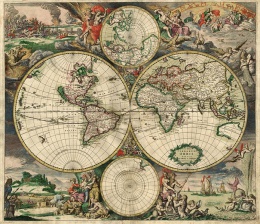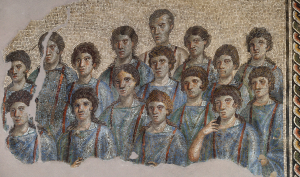Philostratus: Difference between revisions
Created page with "{{History}} '''Philostratus''' or '''Lucius Flavius Philostratus''' (/fɪˈlɒstrətəs/; Greek: Φλάβιος Φιλόστρατος; c. 170 – 247/250 AD), called "the Ath..." |
|||
| (3 intermediate revisions by 2 users not shown) | |||
| Line 8: | Line 8: | ||
==''Erotic Epistles''== | ==''Erotic Epistles''== | ||
[[File:Pavimental polychrome mosaic representing s. c. schola cantorum (close-up).png|thumb|300px| | [[File:Pavimental polychrome mosaic representing s. c. schola cantorum (close-up).png|thumb|300px|left|Close-up of an ancient Roman pavimental polychrome mosaic depicting a sacred choir or ''schola cantorum'' (3rd Century AD), from the temple of Diana Tifatina. Capua, Museo Provinciale Campano.]] | ||
Among the so-called ''Erotic Epistles'' (Early 3rd Century AD), a collection of 73 fictional letters attributed to Philostratus, mostly of amatory subject matter, there are 24 instances in which the addressee is a male youth (Greek: μειράκιον, ''meirakion''; "lad or stripling", usually a teenager),<ref>https://en.wiktionary.org/wiki/%CE%BC%CE%B5%CE%B9%CF%81%CE%AC%CE%BA%CE%B9%CE%BF%CE%BD</ref> his [[Puberty|pubescent]] status being sometimes indicated by conventional references to his sprouting of downy facial hair. | Among the so-called ''Erotic Epistles'' (Ancient Greek: 'Επιστολαὶ 'Ερωτικα ''Erotikai Epistolai'', Early 3rd Century AD), a collection of 73 fictional letters attributed to Philostratus, mostly of amatory subject matter, there are 24 instances in which the addressee is a male youth (Greek: μειράκιον, ''meirakion''; "lad or stripling", usually a teenager),<ref>https://en.wiktionary.org/wiki/%CE%BC%CE%B5%CE%B9%CF%81%CE%AC%CE%BA%CE%B9%CE%BF%CE%BD</ref> his [[Puberty|pubescent]] status being sometimes indicated by conventional references to his sprouting of downy facial hair. | ||
Other traditional Greco-Roman [[Pederasty|pederastic]] motifs included in said compositions are the fleetingness of boyish beauty, the smoothness of youthful male skin, and the mentioning of [[Adolescence|adolescent]] mythological [[Eromenos|beloveds]], such as [[Ganymede]] and [[Hyacinth (mythology)|Hyacinth]]. | Other traditional Greco-Roman [[Pederasty|pederastic]] motifs included in said compositions are the fleetingness of boyish beauty, the smoothness of youthful male skin, and the mentioning of [[Adolescence|adolescent]] mythological [[Eromenos|beloveds]], such as [[Ganymede]] and [[Hyacinth (mythology)|Hyacinth]]. | ||
{{clr}} | |||
==References== | ==References== | ||
Latest revision as of 21:01, 2 July 2022
| Part of the boylove history series |
 |
| Portal:History |
Philostratus or Lucius Flavius Philostratus (/fɪˈlɒstrətəs/; Greek: Φλάβιος Φιλόστρατος; c. 170 – 247/250 AD), called "the Athenian", was a Greek sophist of the Roman imperial period. His father was a minor sophist of the same name. He was born probably around 170, and is said by the Suda to have been living in the reign of emperor Philip the Arab (244–249). His death possibly occurred in Tyre c. 250 AD.
Name and identity
Some ambiguity surrounds his name. The praenomen Flavius is given in The Lives of the Sophists and Tzetzes. Eunapius and Synesius call him a Lemnian; Photius a Tyrian; his letters refer to him as an Athenian.
It is probable that he was born in Lemnos, studied and taught at Athens, and then settled in Rome (where he would naturally be called Atheniensis) as a member of the learned circle with which empress Julia Domna surrounded herself.
Erotic Epistles

Among the so-called Erotic Epistles (Ancient Greek: 'Επιστολαὶ 'Ερωτικα Erotikai Epistolai, Early 3rd Century AD), a collection of 73 fictional letters attributed to Philostratus, mostly of amatory subject matter, there are 24 instances in which the addressee is a male youth (Greek: μειράκιον, meirakion; "lad or stripling", usually a teenager),[1] his pubescent status being sometimes indicated by conventional references to his sprouting of downy facial hair.
Other traditional Greco-Roman pederastic motifs included in said compositions are the fleetingness of boyish beauty, the smoothness of youthful male skin, and the mentioning of adolescent mythological beloveds, such as Ganymede and Hyacinth.
References
See also
- Pederasty in ancient Greece
- Historical boylove relationships in ancient Greece
- Historical boylove relationships in ancient Rome
